United Salvos front serving a weary nation
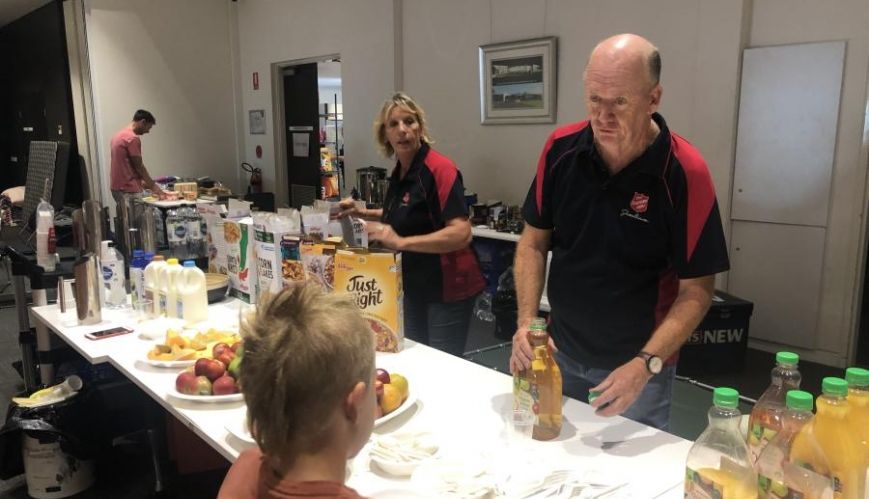
United Salvos front serving a weary nation
5 January 2020
All expressions of The Salvation Army have joined forces to serve those impacted by devastating fires across Australia. Here, Linda Salafia from Ulladulla Salvos and Ulladulla Mission Leader Stephen Dunn serve breakfast at the Ulladulla Evacuation Centre on the NSW South Coast.
Answers to prayer, Aussie camaraderie and grocery shopping in the dark. We take a look at how Salvos have been helping in fire zones across Australia.
National
With The Salvation Army active in fire zones across several states, a national response is being coordinated by the Army’s Strategic Emergency and Disaster Management team. General Manager Major Topher Holland said the emergency response was now involving all expressions of The Salvation Army.
“The Emergency and Disaster Management team is facilitating, but we are working alongside the corps and the local community who are doing amazing work,” Topher said. “All parts of our Army are involved, partnering with the local community. We have Moneycare, Doorways, Salvos Stores, corps officers, their leaders and their people and all of their local partnerships involved.”
Rotating rosters are in place with teams being brought in from other areas of Australia to assist. A team of eight Salvos from New Zealand also arrived in Sydney over the weekend to assist.
New South Wales
In southern New South Wales, which has been devastated by multiple blazes, The Salvation Army is active at evacuation centres in Bega, Moruya, Batemans Bay, Ulladulla and Nowra. In the Snowy Mountains and southern inland, the Army is assisting at Wagga, Bombala, Cooma as well as Canberra in the Australian Capital Territory.
“Our team in the Southern Highlands of New South Wales was present at the evacuation centre at Moss Vale,” said Norm Archer, Strategic Emergency and Disaster Management Coordinator, NSW/ACT. “But at one o’clock this morning (Saturday 4 January) they were relocated to a safer centre at Mittagong, such is the changing nature of this emergency.”
The Salvation Army is also continuing to feed firefighters in the Hunter Valley at the fire-staging ground at Bulga and in the Blue Mountains, west of Sydney.
Batemans Bay Corps Officer Captain Ben Knight said he’d been overwhelmed by the generosity of the community and local businesses. “It’s just astounding how the community has come together,” he said.
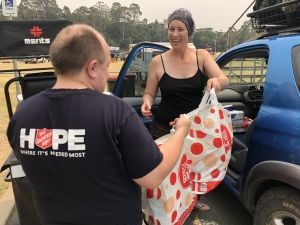 Batemans Bay Corps Officer Captain Ben Knight receives donations from a local community member at the Batemans Bay Evacuation Centre.
Batemans Bay Corps Officer Captain Ben Knight receives donations from a local community member at the Batemans Bay Evacuation Centre.
“We would be talking amongst our team and saying, ‘What are we going to do for dinner?’ and in walks a business owner saying, ‘I’ve got 500 of this or 500 of that ... do you need them?’ God’s got big ears and hears [our prayers].”
Ben said he had done some “bizarre” grocery shopping for the evacuation centre in pitch blackness during a power outage. “All we had was torches, walking down the dark aisles with a trolley!”
Ben also urged people to keep praying for rain. He said that some had fallen but more was needed.
Further south in Bega, Corps Officer Captain Rod Parsons said God’s presence had been felt during the emergency operations at Bega Evacuation Centre. Despite the demands of feeding 3000 displaced people on Saturday 4 January, the combined churches held an impromptu prayer meeting, which was attended by around 100 people.
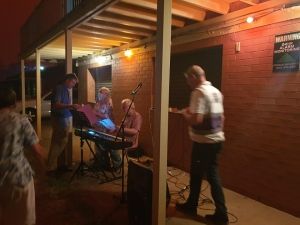 The combined churches of Bega held a prayer vigil at the evacuation centre on Saturday 4 January, when the sky darkened due to bushfire smoke.
The combined churches of Bega held a prayer vigil at the evacuation centre on Saturday 4 January, when the sky darkened due to bushfire smoke.
“It was really powerful,” said Rod. “We had clergy prayer in the main hall in the morning then we had a public prayer meeting in the evening, at about 5pm, which was at the time when the sky was at its darkest too [because of the ash and smoke from the bushfire] and we just got together and prayed over the valley. We had a few musicians come and play songs, ‘Amazing Grace’ and we finished with ‘How Great Thou Art’.
He said the mood at the evacuation centre had been really positive, with locals remaining stoic and pitching in to help where needed. He has urged all Salvationists around the country to pray. “Prayer is what we need at the moment. We need the Lord to work a miracle and put out these fires.”
In the Snowy Mountains regional centre of Cooma, Corps Officers Auxiliary-Lieutenants Anthony and Sandra Barford have been overseeing three activities – the Numeralla Rural Fire Service Staging Area, the Bombala Evacuation Centre and the Cooma Evacuation Centre.
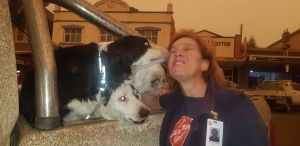 Auxiliary-Lieutenant Sandra Barford takes a short break from work at the Cooma Evacuation Centre to have a cuddle with locals Annie Upton and Gary Shakespeare’s Collie-Cross pooches. Photo: Susan Griffin.
Auxiliary-Lieutenant Sandra Barford takes a short break from work at the Cooma Evacuation Centre to have a cuddle with locals Annie Upton and Gary Shakespeare’s Collie-Cross pooches. Photo: Susan Griffin.
“When the Cooma and Bombala Evacuation Centres opened on New Year’s Eve, all the supermarkets started donating with pallet loads, especially of much-needed water,” said Sandra. “Then local businesses and food services quickly offered pre-cooked food. At the same time, the local community signed up to cater and operate the kitchens.
“We have been blessed by the heart-melting generosity of the hands and feet of locals.”
Victoria
Salvation Army emergency response volunteers are serving at evacuation centres around the state including the main operations in Bairnsdale, Wangaratta, Tallangatta and, from last night, Sale, in the Gippsland region.
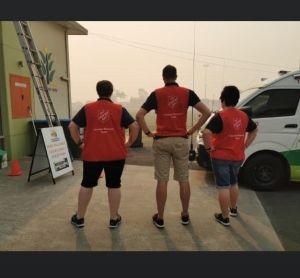 Community Recovery teams are on the ground in Bairnsdale.
Community Recovery teams are on the ground in Bairnsdale.
“There is a lot going on and it’s a trying time for everyone, but we are doing the best that we can,” said Captain Rob Champion, Strategic Emergency and Disaster Management Specialist.
“We have additional SAES volunteers arriving in Bairnsdale to give our local team a break, and teams in Western Australia and Queensland on standby to come if further assistance is required.”
In Sale, people are being airlifted in by military helicopter. The centre there has a capacity for 300 people.
“Salvos Stores brought down 300 beds overnight, and I’d also like to say ‘hats off’ to Aussie Disposals who have helped us in efficiently organising what was needed at a time when our resources are stretched,” said Rob.
In terms of recovery efforts, trained recovery volunteers have already been deployed around the state, with the Department of Health and Human Services referring people who have lost their homes, to The Salvation Army.
“Woolworths has played a critical role in supplying water to evacuees from Mallacoota who we also assisted,” said Rob. “They organised a transport company to get the water onto police boats as people were evacuated, and then also supplied additional water that we met the evacuees with, along with other essentials, in the rest areas set up for them when they got off the boat in Hastings last night.”
South Australia
Salvation Army Emergency Services (SAES) volunteers have been serving firefighters and other emergency services personnel at the Cudlee Creek and Kersbrook fires, and are now catering for the teams on Kangaroo Island.
Recovery efforts are also underway for people who have lost homes in Cudlee Creek.
“We are now able to focus, for the first time in quite a while, on just one location,” said Acting SAES Coordinator Alan Stevens. “The Kangaroo Island fire is still out of control, though, and the entire national park here has been burned.
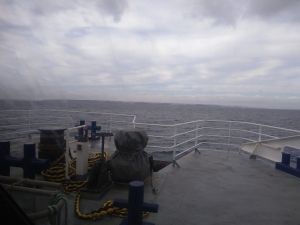 The Salvation Army’s Major Christine Waller took this image on her way to Kangaroo Island in South Australia to assist with the Salvos’ emergency response on the island.
The Salvation Army’s Major Christine Waller took this image on her way to Kangaroo Island in South Australia to assist with the Salvos’ emergency response on the island.
“This kind of activity has never happened in our history – it’s quite an exceptional time, which is the case for everyone in Australia.”
The SAES team has been located in the middle of the island and is now relocating to Kingscote, the biggest town on the island.
“This will give us more access to more firies, many of whom are often fighting fires in very difficult terrain. We also send out takeaway packs. We’re a moving feast!”
There are 700 firefighters battling blazes on the island.
Alan explained that being in Kingscote would also bring the SAES team closer to the airport and allow greater access to relief teams and supplies.
Northern Territory
While the rest of Australia burns, the Northern Territory is in the early stages of a flood alert as a tropical low-pressure system, which is forming along a monsoon trough south of Indonesia, is expected to move towards the west Kimberley coast this weekend, the Pilbara Coast early this week and across the Northern Territory border soon afterwards.
“We are just waiting to see what will happen next,” said Captain Erica Jones, Northern Territory Regional Officer.
“The indications are that the rains will come. We don’t want floods or cyclones, but this is the start of our wet season and we need the rains to get through the dry. While the rest of Australia burns, we are usually flooding. In the dry season, that’s when we burn. The wet is our busiest season in terms of disaster response, so we are on alert, ready, watching and waiting.”
If the system does reach tropical cyclone intensity, it will be named ‘Blake’.
Queensland, Western Australia, Tasmania
In Queensland, Western Australia and Tasmania, Salvation Army Emergency Services volunteers and corps members in previously fire-affected areas are enjoying a welcome reprieve. However, teams are on standby and able to assist should they be required for interstate operations.
Disaster Recovery
Even as the fires continue to rage around the nation, Major Sue Hopper, Strategic Emergency and Disaster Management Specialist, Queensland Division, is in Sydney to assist with recovery efforts.
This includes contacting local Salvation Army expressions in affected areas to determine their availability in the recovery space and preparing to send in some disaster recovery volunteers.
In the NSW Southern Highlands and Lithgow areas, some recovery assessments have already been made, and the team is hoping to expand these efforts into other regions.
“We are providing Salvation Army grants from our public appeal to people who have lost their homes, as well as offering a listening ear, support and hope,” said Sue.
“What we’re doing is immediate help and gives people a bit of hope – something to move forward with one step at a time.
“We want to connect with people as soon as possible to get this help to them because they are already relocating to be accommodated with family and friends. We can connect with them later but want to help as many as we can as quickly as we can.”
Comments
No comments yet - be the first.